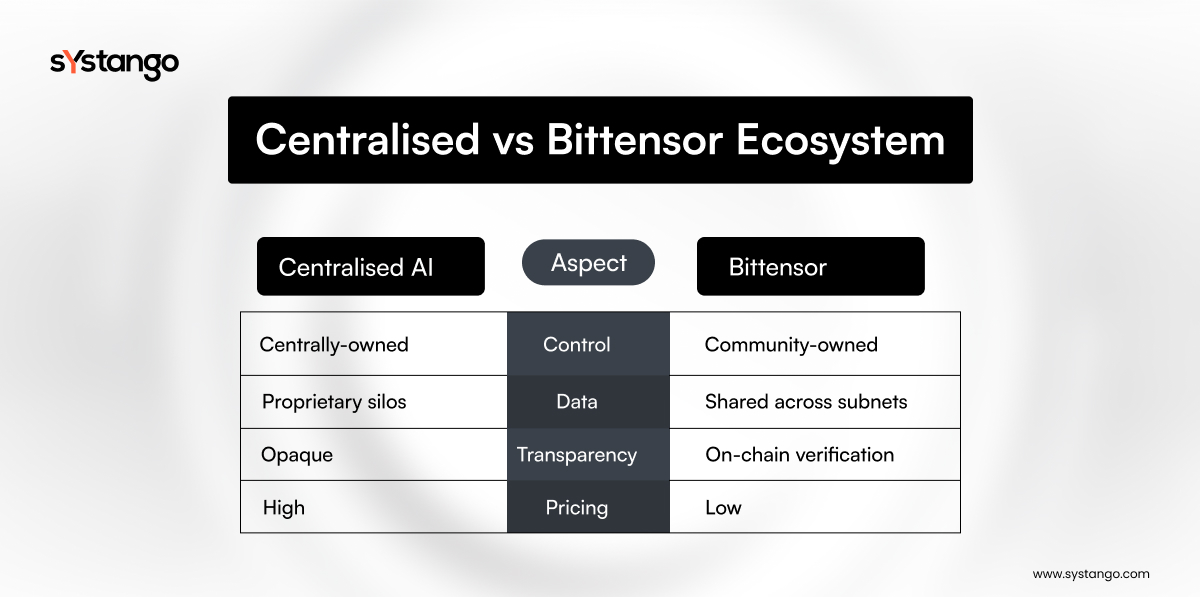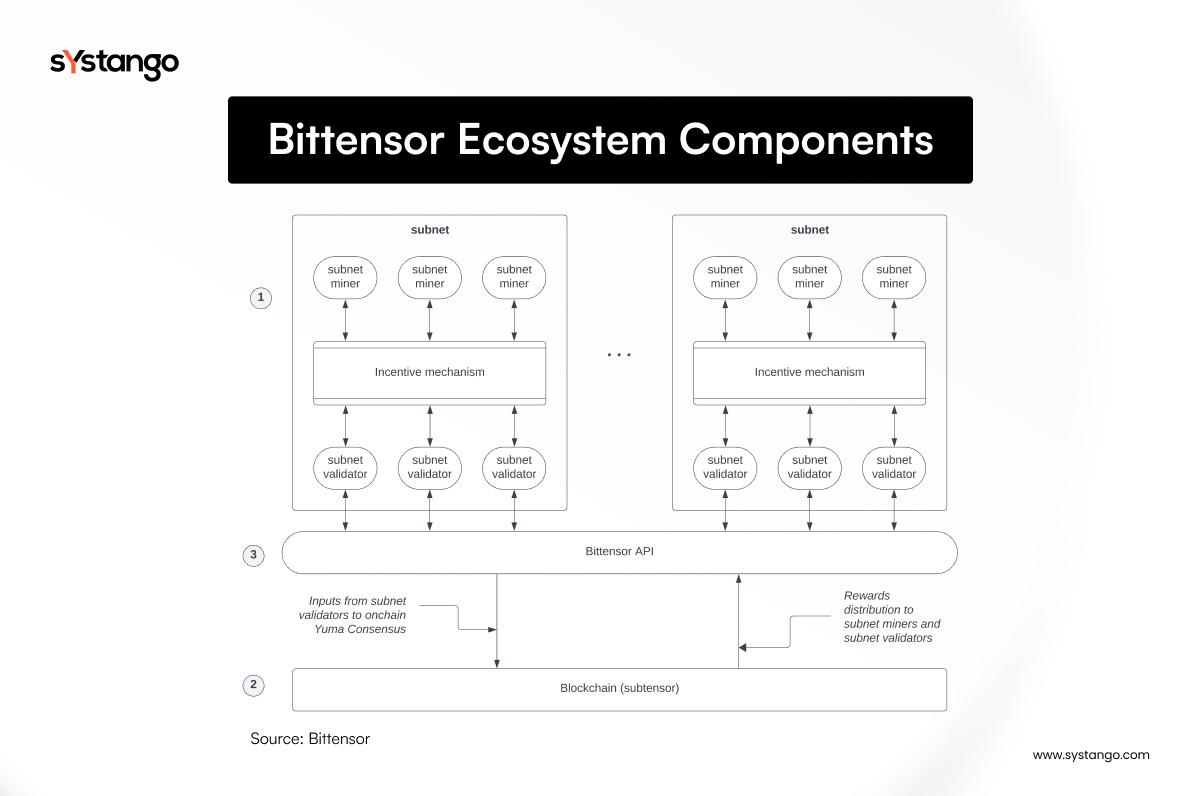Inside Bittensor: How Decentralised Machine Learning Is Redefining AI Collaboration
Published on 10 Nov 2025

Inside Bittensor: How Decentralised Machine Learning Is Redefining AI Collaboration
Artificial Intelligence has become the defining technology of our time, yet it’s still controlled by a few large corporations. Giants like OpenAI, Google, and Microsoft dominate the ecosystem through proprietary data, massive compute power, and closed architectures. This centralisation creates inefficiencies, bias, and limited access for innovators and smaller players.
That’s where Bittensor steps in: an open, decentralised protocol designed to democratise machine learning. It’s a peer-to-peer network that enables anyone to contribute models, computing power, or data, and earn rewards for their value. In essence, Bittensor is building a global, decentralised marketplace for intelligence, powered by blockchain and incentivised through the TAO token.
I. The Problem: AI’s Centralisation and Its Limitations
Bittensor emerged to solve the most pressing issues of the modern AI ecosystem:
-
Centralisation and monopolisation: AI’s control lies with a handful of corporations, leading to limited innovation, data silos, and biased systems.
-
High entry barriers: Building AI systems traditionally demands immense capital, specialised infrastructure, and top-tier data science talent.
-
Lack of transparency and trust: Proprietary algorithms function as black boxes with minimal accountability.
-
Poor collaboration: Data silos hinder open knowledge exchange, slowing collective AI progress.
-
Narrow evaluation metrics: Traditional AI models often optimise for narrow benchmarks, missing broader problem-solving potential.
Bittensor disrupts this paradigm. It enables open collaboration, transparency, and fair value distribution, allowing AI innovation to emerge from anywhere in the world, not just elite labs.
II. How Bittensor Works
Bittensor operates through a multi-layer architecture that mirrors how cloud and AI systems work, but in a trustless, decentralised way.
- Blockchain Foundation (Subtensor)
Built on the Substrate framework, Subtensor serves as Bittensor’s blockchain backbone. It maintains records of all rewards, staking events, and model performance. Every contribution, from training data to model output, is tracked transparently, ensuring no single entity can manipulate the system.
- Subnets: The Intelligence Marketplaces
Each subnet functions as a decentralised marketplace for a specific AI domain. Developers and “miners” train models to solve problems within a subnet: text generation, image recognition, trading algorithms, or 3D asset creation. Validators then evaluate these outputs and reward high-quality contributions using TAO tokens.
With over 118 of 128 subnets already active, and the count steadily rising, Bittensor’s network spans domains such as:
-
Decentralised Cloud Infrastructure
-
Compute
-
Storage
-
Financial
-
Interoperability
-
Natural language processing
-
3D model generation
-
Deepfake detection
-
AI trading models
-
Healthcare prediction
Moreover, subnets with lower performance are gradually phased out.
Consensus & Incentives (Yuma Consensus and dTAO)
Bittensor’s Yuma Consensus mechanism ensures fair evaluation of model quality. In 2025, the introduction of dynamic TAO (dTAO) transformed participation by introducing subnet-specific Alpha tokens.
Here’s how it works:
-
TAO holders stake tokens in a subnet and receive Alpha tokens in return.
-
Successful subnets attract more staking and capital, driving higher TAO emissions.
-
This creates a market-driven feedback loop, rewarding innovation and subnet performance.
Rewards are distributed as follows (as per Bittensor documentation and protocol papers, these percentages represent the standard emission split per block):
-
41% to miners
-
41% to validators and delegators
-
18% to subnet owners
This ensures every role in the network has a financial incentive aligned with quality and collaboration.
III. Real-World Applications
Bittensor’s open architecture supports real business use cases across industries:
-
AI development: Natural language models, image recognition, and code generation.
-
Finance: Algorithmic trading and fraud detection.
-
Healthcare: Predictive diagnostics and research acceleration.
-
Compliance: Synthetic identity generation for secure testing.
-
Gaming & Metaverse: 3D asset creation for gaming and virtual worlds.
-
Cross-chain interoperability: Bridges that link Bittensor with Solana, Ethereum, and Base, as seen in Systango’s VoidAI project.
-
Cloud Infrastructure: Increased computational power and infrastructure enhancement, as observed in Systango’s Nodexo project.
This flexibility makes it one of the most adaptable decentralised systems currently active in the blockchain and AI convergence space.
IV. The Role of TAO in Network Growth
TAO, Bittensor’s native token, is the economic backbone of the ecosystem. With a capped supply of 21 million tokens and a halving model inspired by Bitcoin, it is designed for scarcity and long-term value.
In line with Bittensor’s open and merit-based model, there were no pre-allocations or VC rounds; every TAO must be earned.
TAO’s structure encourages:
-
Miners to contribute models
-
Validators to ensure integrity
-
Subnet creators/owners to innovate
-
Stakers/delegators to secure the network
This transparent, multi-layered economy allows Bittensor to sustain itself organically while incentivising quality and collaboration.
V. Systango’s Role: Building the Future with Bittensor
At Systango, we help businesses harness the potential of Bittensor to create intelligent, interoperable, and decentralised AI ecosystems. Combining our expertise in AI engineering and Web3 infrastructure, we enable enterprises to build AI systems that are transparent, scalable, and economically sustainable.
Through Bittensor, Systango empowers organisations to:
-
Develop and launch custom AI subnets aligned with specific business needs.
-
Enable cross-chain interoperability across major ecosystems like Ethereum, Solana, Base, and Bittensor.
-
Engineer tokenomics frameworks and smart contracts to drive collaboration and fair value exchange.
-
Integrate AI workloads with decentralised compute for performance and transparency.
-
Manage end-to-end infrastructure with enterprise-grade reliability.
Our hands-on experience extends beyond theory. Through initiatives like VoidAI and Neural Internet, we’ve demonstrated how decentralised AI can deliver real business impact.
-
VoidAI (subnet 106) enhances liquidity and interoperability across AI and blockchain ecosystems.
-
Nodexo (formerly Neural Internet, subnet 27) powers a decentralised GPU marketplace, enabling scalable and efficient AI compute within the Bittensor network.
As Systango continues to expand the boundaries of decentralised AI through Bittensor, the possibilities for intelligent collaboration across networks are only just beginning.
Conclusion
Bittensor marks a paradigm shift in how intelligence is created, shared, and rewarded. By decentralising machine learning, it opens new doors for collaboration without central control, where innovation thrives on transparency, merit, and open contribution.
At Systango, we’re proud to be part of this transformation, building real-world implementations that bring decentralised AI to life. From powering subnets to designing bridges and scalable infrastructures, we help businesses leverage Bittensor to unlock new efficiencies and opportunities across the AI and Web3 spectrum.
But what happens when intelligence doesn’t just connect, it starts to trade, move, and create value across networks?
Things start to get exciting here, and that’s the frontier we explore next with VoidAI, a pioneering subnet where interoperability and liquidity power the next phase of decentralised intelligence.
Related posts
Blockchain
Blockchain Development Services for Enterprises: Unlock Efficiency, Trust, and Real Business Impact
21 May 2025
Blockchain
Web Apps
NFT
App Development
The Ultimate Guide to Hiring Blockchain Developers in 2025: Skills, Costs, and Models
15 Apr 2025
Let’s talk, no strings attached.


